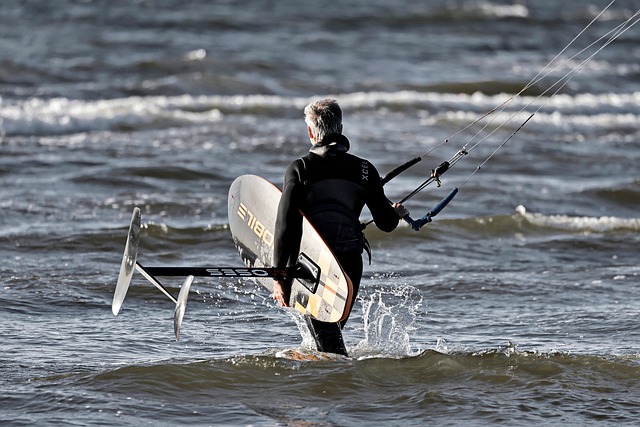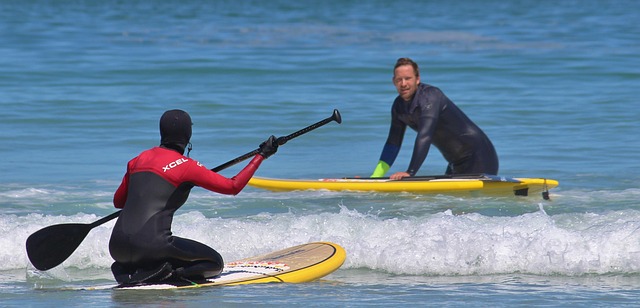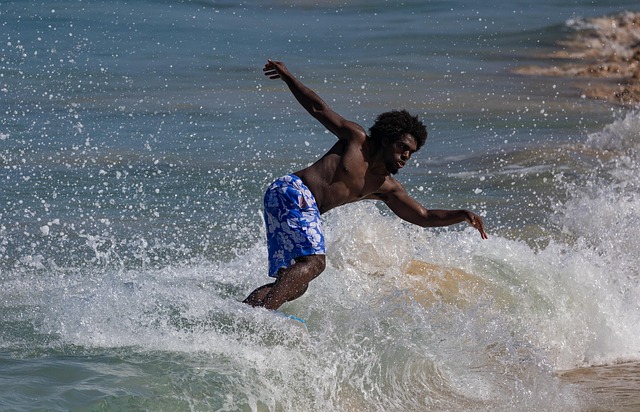When selecting a surfboard as a beginner, prioritize your height and weight for optimal stability. Choose fuller, buoyant boards with rounded edges and wider noses for easier manoeuvring. Consider local conditions and consult experts or experienced friends to tailor the choice. Beginner-friendly boards are generally 6-8 feet long, providing balance and stability for learning fundamental skills. Wider tails offer enhanced stability while narrower tails enable faster speeds and tighter turns as skill improves. Regular cleaning, fin maintenance, and proper storage extend board life.
“Unsure where to start in the vast world of surfboards? Choosing the right board as a beginner can be overwhelming, given the diverse range of sizes available. This comprehensive guide navigates you through every step, from understanding your body type and skill level to exploring popular sizes and essential dimensions. Learn how tail shapes and care routines vary with size, ensuring you select the perfect surfboard for your journey into the waves, enhancing both stability and performance as a novice surfer.”
What to Consider When Choosing a Surfboard for Beginners

When choosing a surfboard for beginners, several key factors come into play. First and foremost, consider your height and weight. A general rule is to look for a board that allows you to stand upright with both feet on the deck, providing stability and balance. For instance, shorter boards are typically easier to manoeuvre in smaller waves but may not be suitable for taller individuals.
Additionally, the shape and volume of the surfboard matter. Beginners often benefit from fuller, more buoyant boards that offer better floatation, making it easier to catch waves and stand up. Look for designs with rounded edges (not too pointy) and a wider nose, which can help in turns and provide stability during rides. Remember, it’s always a good idea to consult with surf experts or experienced friends who can guide you based on their knowledge and the local conditions.
Determining Your Body Type and Ideal Board Size

When choosing a surfboard, one of the first things to consider is your body type and the level of experience you have. For beginners, selecting the right board size is crucial for learning and enjoying the water. Generally, a longer board with more buoyancy provides stability, making it easier to catch waves. This type of surfboard for beginners is ideal for larger bodies as it offers extra floatation.
Determining your body weight, height, and surfing experience will help you pick the perfect size. Surfboards come in various lengths, from short and agile boards suitable for small waves to longboards that are best for bigger breaks. As a beginner, opt for a board that allows you to paddle out with ease and catch waves consistently. The ideal length should enable you to stand comfortably while keeping your balance, ensuring a positive learning experience on the surfboard for beginners.
Popular Surfboard Sizes for New Surfers

For new surfers looking to dip their toes into the ocean, choosing the right surfboard size is a crucial first step. Typically, surfboards designed for beginners are shorter and wider, offering more stability and balance—essential skills to master before tackling bigger waves. These boards often range from 6 to 8 feet in length, with widths around 20 to 23 inches at their widest point. Such dimensions make them ideal for learning as they provide a more forgiving ride, allowing beginners to focus on catching waves, improving their paddling technique, and developing fundamental surfing skills without feeling too overwhelmed by the board’s performance or handling.
The popular 6-foot longboard is a classic choice for newcomers, offering a smooth and gentle learning curve. Alternatively, a 7-foot fish or funboard can be an excellent option for those who prefer a more manoeuvrable board while still retaining stability. These boards are versatile and well-suited for various water conditions, making them perfect for building confidence and mastering the art of surfing at its most basic level.
Factors Influencing Surfboard Length Selection

When choosing a surfboard, especially as a beginner, several factors come into play, determining which length suits your skills and preferences best. One key consideration is your height and weight; generally, longer boards provide more stability for larger surfers or those with less experience. However, shorter boards offer agility and maneuverability, making them ideal for smaller individuals or advanced riders who prefer tighter turns.
The type of surfing you intend to do also influences board length. If you’re a beginner focusing on learning to catch waves and gain balance, a longer board (typically 8-10 feet) is often recommended as it provides more surface area for stability. In contrast, shortboard designs (under 6 feet) are designed for sharper turns and faster speeds, catering to experienced surfers who want to perform advanced maneuvers in larger swells.
Width and Volume: Key Dimensions for Stability

When considering a surfboard for beginners, understanding width and volume is crucial for stability. The width of a surfboard plays a significant role in how well it floats and steers. Wider boards provide more buoyancy, making them ideal for smaller waves or beginners who need extra balance. However, narrower boards offer enhanced maneuverability, which can be beneficial for catching waves faster and performing basic turns.
In terms of volume, larger surfboards displace more water, ensuring riders stay afloat with ease. This is particularly advantageous for novice surfers who may struggle to paddle out to the break. Conversely, smaller volumes make the board lighter and easier to maneuver, allowing beginners to gain confidence more quickly. The key is finding a balance between width and volume that suits your skills and wave conditions you intend to surf.
Tail Shape Variations and Their Effects on Performance

Surfboards come in a range of tail shapes designed to cater to different riding styles and skill levels, with options suitable for both beginners and experienced surfers. The tail shape, or fin setup, is a key factor in determining a surfboard’s performance and manoeuvrability. For beginners looking to catch more waves and learn to turn easier, a wider tail shape offers increased stability and lift, making it simpler to execute turns and maintain balance.
In contrast, advanced surfers often prefer narrower tail shapes for their faster glide, tighter turns, and enhanced manoeuvrability. These designs enable expert riders to carve precise, dynamic lines in the water. The variety of tail shapes available allows surfers to choose a board that aligns with their unique preferences and skill sets, optimising their surfing experience whether they’re paddling out for the first time or honing their cutbacks.
Choosing the Right Board for Your Skill Level and Riding Style

When selecting a surfboard, choosing the right one depends on your skill level and riding style. For beginners, it’s best to opt for a longer board, typically 8–10 feet in length. These boards offer stability and make it easier to catch waves, allowing you to focus on learning balance, stance, and basic surfing techniques without getting overwhelmed by speed or agility requirements.
The surfboard’s shape also plays a significant role. Beginner boards often have rounded edges and a fuller outline, providing more buoyancy and forgiveness during maneuvers. As you progress, you can transition to shorter boards for improved maneuverability if you prefer a more dynamic riding style or focus on performance surfing.
Tips for Testing Different Surfboard Sizes

When it comes to choosing a surfboard, one of the most important factors is understanding your skill level and body type. As a beginner, testing different surfboard sizes can seem daunting, but it’s a crucial step in finding the perfect fit. Start by assessing your height and weight; surf shops often have size charts that guide you based on these measurements.
Begin with a board that’s slightly longer than your height to provide better stability, especially when standing up for the first time. For instance, if you’re between 5’6″ and 5’10”, consider a 7-foot surfboard. This size offers buoyancy and manoeuvrability, making it ideal for beginners learning to catch waves. Always remember, the right board will make learning easier and more enjoyable, so take your time to test various options before committing to one.
How to Care for Your Surfboard Based on Size

When it comes to choosing a surfboard, size matters—not just in terms of length but also how it aligns with your skill level. For beginners, a surfboard that’s between 7 and 9 feet long is ideal. These boards offer a balance between stability and maneuverability, making them perfect for catching waves and building confidence in the water.
Caring for a surfboard suited to a beginner’s needs involves regular cleaning and maintaining its shape. For smaller boards, pay close attention to the fins; ensure they’re secure and aligned properly. Due to their size, these boards are often more susceptible to dings and dents, so frequent checks and repairs can prevent significant damage. Always store your surfboard in a protected area, avoiding direct sunlight and extreme temperatures to preserve its quality and longevity.
